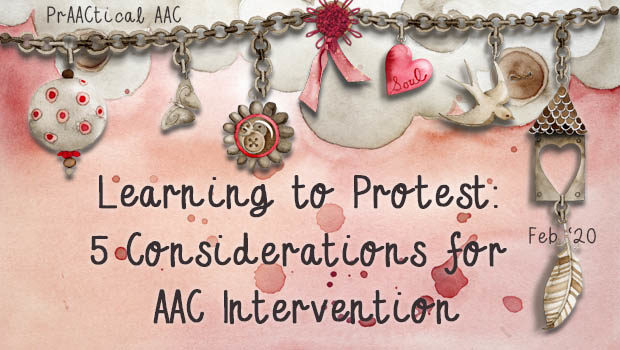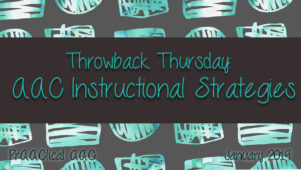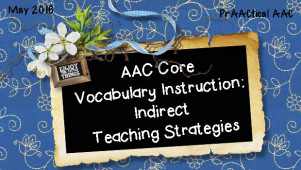Learning to Protest: 5 Considerations for AAC Intervention

Stop it.
No, thank you.
Don’t do that.
I don’t want ___.
Not now.
In order to be able to express what they are really thinking, AAC learners need the vocabulary and skills to be able to tell us when they don’t like something or when they do not want to participate. Here are some thoughts about facilitating their growth in this area.
- Review the vocabulary and messages that are available to the learner. Consider single words (e.g., no, not, stop) and contractions (e.g., don’t, can’t, won’t, shouldn’t), as well as prestored messages that will make it faster and easier to express themselves under stressful conditions when the need for protesting is most important (e.g., I don’t want to. I want you to stop. Don’t make me to that.).
- Model negation in various contexts. Narrate your own experiences throughout the day (e.g., I don’t want to eat that. Stop touching me. That’s not what I want.) to demonstrate the validity of protesting, the various situations in which it can be used, and the way that these messages are conveyed in the AAC systems used by the AAC learners with whom you work.
- Narrate their experiences with protesting. When AAC learners are showing signs of protesting using nonverbal means (e.g., voice, body movement, refusal), use AAC to model the language that helps them relate those experiences to words that can be used to describe or react to them (e.g., You look unhappy. I think you want me to stop. You sat down. I think you are saying ‘I do NOT want to go.’)
- Acknowledge attempts to protest and honor them whenever possible. As an AAC user begins to express messages of protest, acknowledge those messages even if you can’t comply with them (e.g, I think you’re telling me ‘I do not want to read.’; I know you don’t want to go inside. But recess is over and it is too cold to stay out.) Honor the messages whenever possible, particularly during the early stages of learning these skills, so that the AAC user sees that their communicated intent has the desired impact.
- Create teaching scenarios to develop this skill. While we can and do use naturally occurring situations to model protesting, those situations can be too stressful for the learner to really focus on what they need to learn to better express themselves in these situations. Consider going beyond those ‘teachable moments’ and crafting planned instructional experiences to work on this skill. Start with positive or neutral situations, then work up to low-stress conditions.
- Positive conditions: After choosing a preferred activity/object, teach the language of rejecting to label the options that the learner does not want. After Mayra, picked her favorite book, we then helped her express that she does not want the other two choices. When Hunter told us he wanted to stop a fun activity, we helped him say ‘no more.’ In these examples, we are validating their choices but also helping them practice the language for doing this in different ways.
- Neutral conditions: AAC learners make many choices throughout the day, sometimes in situations where none of the options are considerably better or more desirable than the other. For example, a preschooler may choose which color to use for an art project or which puzzle to play with during free time. Once those choices have been made, add negation to the activity/object label to practice this skill (e.g., Blue. Not yellow. Not red.; You picked the train puzzles. No animal puzzle today.).
- Low-stress conditions: Help the learner develop protesting skills by using them to explain what is happening in pictures, videos, or in the world around them (e.g., Curious George does not like that. Uh oh! He cannot go in! You’re watching Jessi. She’s upset. She does not want to come with us.). Then move up to real-world situations where protesting is likely to be needed but the communicator’s stress level is still low. David’s teacher, for example, helped him say ‘No, thank you’ when a peer invited him to play since David was engrossed in a train magazine. Later, she helped him decline things that others offered him (e.g., I don’t want that. Not now.).
Have you had experiences in teaching the skill of protesting and helping AAC learners become able to use that to express themselves? We’d love to hear about them.
Filed under: Featured Posts, PrAACtical Thinking
Tagged With: AAC intervention, protesting, rejecting
This post was written by Carole Zangari




